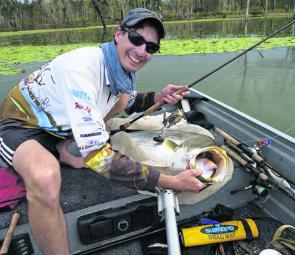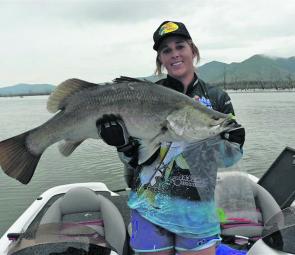Team Power (Trent Power/Donovan Power) took out the first event of the 2013 BARRA Tour, the Peter Faust Evening Event. Team Power’s tournament limit of 9/10 for a total of 925cm saw them secure a comfortable victory and provide the perfect start to their 2013 ABT tournament season.
During the prefish day Team Power fished a number of proven locations, sounding good numbers of barramundi.
“The fish were there and responding to a Stiffy Bony Bream lure,” Trent said.
In the first session Team Power travelled to a clearing near the old powerlines where they fished a point next to a gully.
“We targeted a section of bank around 50m long, casting to a lily edge in 2-4m of water,” Trent explained. “We had a concentrated bite window between 2.30pm and 4.30pm when we caught three of our fish. We then checked out the adjacent weedy flats and the old creek line before returning to our key area.”
“The team’s session one total of 5/5, 503cm had them sitting in second place and poised to challenge the leader.”
On day two Team Power returned to the same section of bank but were unable to find any fish. They moved to a nearby location, Pandanus Bay, which had two branching arms with a flat in between. The team moved further up the creek for no fish before moving back to the flats. Then there was a quiet spell, and they were just about to move when they caught and landed their first fish of the session. They opted to stay, and their decision was rewarded with two more fish coming before sunset.
In a final throw of the dice the team headed to fish the main basin.
“We were fishing around 250m from the buoy line with plenty of other boats,” Donovan said. “We were marking plenty of baitfish and barramundi in the area. The soundings indicated that the bait was holding in 20-30ft with active barra sitting underneath. Surface activity indicated that the fish were active. I was casting out and slow rolling the lure when I got a hit with 20 minutes to go. The barra went 117cm and was our final fish for the session.”
The team’s most productive lures were a 130mm Squidgy Slick Rig in black/gold and white, both rigged on Area 51 jigheads. During the day the team used the black/gold and at night switched to the white.
Trent said the key areas were small in size with adjacent rivulets nearby.
“While we sounded fish in the deep they weren’t feeding,” he said. “The majority of the fish we caught were barra sitting tight to the edges.”
Team Nomad Tackle/HydroWave caught 8/10, 781cm to finish in second place. Leading after day one, the pair found the fishing harder on day two and were overtaken by a fast-finishing Team Power.
“We had a good prefish where we caught fish and identified our key locations,” Elliot explained. “We found four areas we could focus on depending on the wind direction and amount of traffic in the area.”
On day one the team headed to a shallow bank near the existing powerlines. The bank had an adjacent deep channel, providing the team with multiple options. They employed their HydroWave to activate the baitfish in the vicinity.
“The HydroWave is an electronic sound device that emits the natural sounds of both baitfish and predatory fish feeding on them,” Reichard explained. “Together the sounds produce an instinctive response in nearby predatory fish. The predatory fish can hear the sounds and feel the vibrations of the sound waves in the water.
“We used the Australian freshwater edition and toggled between bony bream passive, freshwater shrimp and redclaw/yabby. We set the HydroWave on a 30 second sound loop on a 50% volume setting.”
The barramundi were active, moving through in groups of two and three. Between 3pm and 4pm a distinct bite window occurred, with the team capitalizing and landing four fish.
“We constantly mixed up the presentations, with one team member using a different lure from the other,” Reichard explained. “This was either a hardbody or larger lure.”
The key lure for the session was a 130mm Squidgy Slick Rig in black/gold rigged on a 1/2oz Area 51 jighead. The retrieve was a slow roll punctuated with hops, and hook-ups were solid with the fish hitting the lure aggressively.
Team Nomad Tackle/HydroWave led the field after the first session with 5/5, 521cm. With an average fish size of 104.2cm the team were confident they were in the right area and anticipated a good day two session.
On day two the wind direction changed, but despite this challenge the team decided to stick with their successful day one plan. Even though there were fewer bites, the team cottoned onto an important bite trigger, as Elliot explained.
“Occasionally surface activity would erupt around the boat,” he said. “The key was to quickly cast to those activity areas to get a bite. It was about being in tune with what was happening around you.”
The team finished with 3/5, 260cm which secured them overall second place and valuable Team of the Year (TOY) points.
The outfits of Team Nomad Tackle/HydroWave consisted of a 7’, 8-14kg 13 Omen black rod teamed with Daiwa Certate 3000/Shimano Sustain 4000 reels spooled with 20lb Powerpro braid and 80lb Black Magic tough trace.
The event Big Barra (118cm) was caught in session two by Geoff Newby (Team MTA Blue).
“The fish was caught at 2.10pm from below the existing powerlines,” Newby explained. “We were anchored in 6ft casting back to a lily edge in 2ft of water. I used a medium paced retrieve when the fish hit the lure [130mm Squidgy Slick Rig in black/gold]. The fish gave some fight, breaching a couple of times before coming to the boat. Fortunately my stinger hook was effective as it was hooked in the lip. It was very exciting to catch a fish like that during a tournament.”
Facts
Winning tackle
Rod: 6’6” 6-8kg Shimano Raider rods
Reel: 4000 size Daiwa Certate/Shimano Symetre
Line: 30lb Fins braid
Leader: 60lb YGK fluorocarbon and 80lb SureCatch leader
Winning Ways
“We took the opportunities when they presented themselves, and we were confident in the locations we chose. Understanding why areas were holding fish and knowing enough locations with similar characteristics made the difference. We could identify areas that weren’t as heavily pressured and the fish would respond accordingly. This all came about due to time and experience on the water.
“Also having a smaller boat (3.75m/25hp) proved useful around trees and small creek areas. Being manoeuvrable can sometimes be the difference between catching and losing fish.”

Team Power, consisting of Trent Power and Donovan Power, were the clear winners in the tournament.

A solid Peter Faust barramundi caught by Georgette Elkins.




